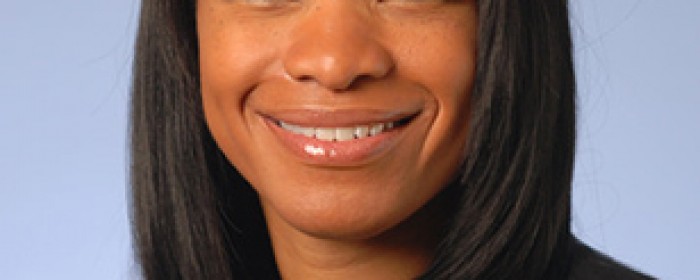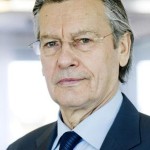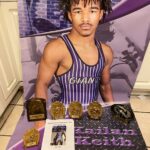Doforself Daughter – INDIANA UNIVERSITY
Faculty & Staff Spotlights
Q-and-A with NiCole Keith, vice president of the American College of Sports Medicine
NiCole R. Keith, Ph.D., a scientist with the IU Center for Aging Research and investigator with the Regenstrief Institute, was recently elected to a two-year term as vice president of the American College of Sports Medicine.
The largest sports medicine and exercise science association in the world, the American College of Sport Medicine has more than 50,000 members representing a variety of medical specialties, allied health and scientific disciplines. A longtime member of the ACSM, Dr. Keith directs the organization’s Leadership and Diversity Training Program and has been an ACSM fellow since 2007.
Dr. Keith is also a founder of Physically Active Residential Communities and Schools, a collaborative effort between Eskenazi Health, the School of Physical Education and Tourism Management at IUPUI, the Chase Near Eastside Legacy Center and the Indianapolis Public Schools. She is an IUPUI associate professor of kinesiology.
How did you get into the field of physical activity research? What is the focus of your work?
I was working on my Ph.D. at the University of Connecticut during Operation Desert Storm and the Department of Defense awarded funds to study how birth control influenced thermoregulation during physical exertion in extreme environments. My job was to recruit and train college-aged women, just like boot camp. Poor fitness was an inclusion criteria and most of the women were overweight or obese. For three years, we started training in August and by each March women had amazing transformations – physically, academically and socially. I saw what physical activity could do to make people healthier in so many ways. I knew I no longer wanted to be a bench scientist but instead, a physical activity researcher. My research focus is to close the health disparities gap through physical activity as a method of health promotion.
What does your work involve at the Regenstrief Institute and IU Center for Aging Research?
My affiliation with the IU Center for Aging and Regenstrief Institute began when I arrived on campus in 2002 under the mentorship of IUSM faculty members Christopher Callahan, M.D.; Daniel Clark, Ph.D.; and Douglas Miller, M.D. Since the beginning, Dr. Clark and I have done research around an Eskenazi Health clinic-based program called Healthy Me (previously called Take Charge Lite at Wishard). Overweight and obese patients are referred to Healthy Me and are coached to lose weight. Additionally, Drs. Callahan, Clark, and Miller served as primary mentors on a NHLBI K01 that was completed in May 2013. I am in the process of revising a R01 for a resubmission later this year.
Why did you found Physically Active Residential Communities and Schools? What does this group do?
During my interaction with Healthy Me providers, I asked why they didn’t refer patients to exercise programs. They said their main reason was they lacked of confidence in the patient’s ability to overcome barriers to exercise, including cost, transportation, comfort and knowledge. At the same time, I noticed that in my students in the School of Physical Education and Tourism Management at IUPUI, where I teach students to be health and fitness professionals, were not well prepared to create exercise programing or fitness assessments appropriate to most people since they had very little experience working with anyone beyond their classmates. (Kinesiology majors typically don’t look like the general population in terms of fitness and health.) Their lack of experience with “real people” also made it difficult to place them in internships.
 Dr. Keith tests a fitness assessment pod at the Near Eastside Legacy Center
Dr. Keith tests a fitness assessment pod at the Near Eastside Legacy Center
PARCS addresses both issues. Providers refer patients with multiple medical conditions (or “comorbidities”) to exercise and students, overseen by faculty members, perform fitness assessments, create exercise programming and guide individual and group fitness training with those who are referred. About 200 students do service learning in PARCS each semester and the program currently serves about 1,200 adult members, with 70 percent referred from Healthy Me. Costs remain low because the fitness professionals are students who receive academic credit for service learning at PARCS. The program is located on the properties of three Indianapolis high schools near Eskenazi clinics and the cost remains low. We’ve been going strong for 11 years!
How is the country’s lack of physical activity impacting health?
Physical activity can be inexpensive or free and positively influences several diseases including diabetes, coronary artery disease and cancer. Still, only 30 percent of the US population meets the US Physical Activity Guidelines. Last month I was at the American College of Sports Medicine Annual Meeting where the Acting US Surgeon General, Boris Lushniak, M.D., named physical activity a major public health problem. Getting people to be active is a challenge, but making this happen would positively influence the physical and fiscal health of Americans.
How are IUSM researchers contributing to solve this challenge?
The U.S. Physical Activity Guidelines resulted from decades of research that focused on the amount and intensity physical activity necessary to impact health. The next step is to determine best ways to get people, especially those who are most sedentary, active. Healthy Me is one example. Other faculty members with whom I collaborate in the IU School of Medicine include David Marrero, Ph.D., and Mary de Groot, Ph.D., in the Diabetes Translational Research Center.
What is your role the director of the Leadership and Diversity Training Program at the American College of Sports Medicine?
ACSM is strategically increasing the diversity of the organization’s leaders. The purpose of the Leadership and Diversity Training Program is to mentor graduate students and junior faculty who are underrepresented minorities into ACSM Fellowship and leadership. Only fellows can be nominated to the Board of Trustees and I was the first African American to be elected to the Board of Trustees. Only former trustees can be elected to higher offices. LDTP participants are matched with fellows who have similar research interests so this helps with academic and professional development activities at their academic institutions or medical facilities as well.
What are your main goals or priorities as the new vice president of the ACSM?
As vice president for education and credentialing, I am assigned oversight of 10 committees. I haven’t previously served on any of these committees so I hope to provide fresh eyes and useful input. I am working with other leaders to improve membership engagement within the ACSM and engagement with the national and international populations that need our service and care the most. This includes increasing the number of underrepresented minorities and women who are Fellows. Influencing diversity in providers and fitness professionals is an important part of ACSM’s strategic plan.
Do you participate in any sports, or did you in college or high school?
While I’ve always been physically strong and super competitive, I was never very athletic. I played club soccer in college and loved to run until about two years ago when my hips said, “no more.” I’m a second degree black belt in karate and try to get to the dojo one to two days each week. I still do cardio and resistance training five to six days a week — practicing what I preach.

















